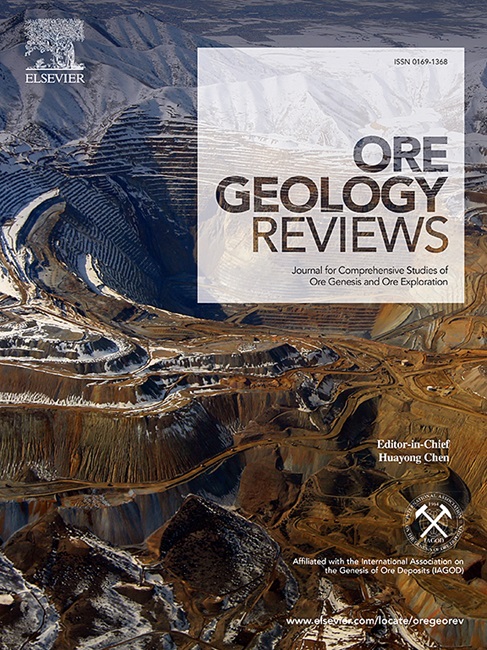Mid-Late Jurassic magmatism and its mineralization potential in the Dayaoshan district, southwest Qinhang metallogenic belt, South China
IF 3.2
2区 地球科学
Q1 GEOLOGY
引用次数: 0
Abstract
The Mid-Late Jurassic is a significant period characterized by extensive magmatism and mineralization within the Qinhang metallogenic belt. However, the genesis and metallogenic potential of these Mid-Late Jurassic granitoids in the Dayaoshan district, the southwest part of the Qinhang metallogenic belt, remain inadequately investigated.
The Dayaoshan Mid-Late Jurassic granitoids primarily comprise the Fuqing granodiorite (161.5 ± 3.2 Ma), Dabang granodiorite (157.4 ± 2.4 Ma), Dabang granodiorite porphyry (155.9 ± 2.8 Ma), Shangdong granodiorite (153.7 ± 2.8 Ma), Fenghuang granodiorite (162.6 ± 1.1 Ma), and Yuanzhuding granite porphyry (154.3 ± 1.7 Ma). These rocks exhibit typical I-type affinity, marked by lower A/CNK values (0.9–1.1) and the presence of magnetite. Whole-rock Nb/Ta ratios (9.0–14.0), biotite major elements, apatite trace elements, Mg# value (35–63), and zircon εHf(t) (–19.7–4.2) and TDM2 (2440–834 Ma) indicate that the Dayaoshan Mid-Late Jurassic granitoids likely originated from remelting Precambrian metamorphic crustal material with some mantle material inputting. The higher Mg# value (52–63) and more positive εHf(t) value (–6.3–4.2) of the Yuanzhuding granite porphyry, genetically associated with porphyry Cu-Mo mineralization, suggest it contains more mantle-derived material compared to other granitoids. Regarding magma evolution, apatite and/or whole-rock trace elements show that the Fuqing granodiorite is dominated by amphibole fractionation, while the Dabang granodiorite, Dabang granodiorite porphyry, and Shangdong granodiorite are characterized by plagioclase fractionation. Based on the existing research on the Mid-Late Jurassic tectonic-magmatic activities in the Qinghang metallogenic belt, it is inferred that the Dayaoshan Mid-Late Jurassic granitoids are products of asthenospheric upwelling caused by the subduction of the Paleo-Pacific plate. The Dayaoshan Mid-Late Jurassic granitoids, excluding the Yuanzhuding granite porphyry, generally exhibit characteristics of low differentiation, low oxygen fugacity, and crust-mantle mixed source, thereby excluding the possibility of associated W-Sn and Cu mineralization. The mineralization age (Mid-Late Jurassic) along with S–Pb–H–O isotope compositions of lode gold deposits in the Dayaoshan region support their genetic linkage with the Mid-Late Jurassic magmatism, consistent with high water and gold content and low differentiation of the Dayaoshan Mid-Late Jurassic granitoids (except Yuanzhuding). This research highlights a good prospect for lode gold deposits around the Mid-Late Jurassic granitoids in Dayaoshan.

求助全文
约1分钟内获得全文
求助全文
来源期刊

Ore Geology Reviews
地学-地质学
CiteScore
6.50
自引率
27.30%
发文量
546
审稿时长
22.9 weeks
期刊介绍:
Ore Geology Reviews aims to familiarize all earth scientists with recent advances in a number of interconnected disciplines related to the study of, and search for, ore deposits. The reviews range from brief to longer contributions, but the journal preferentially publishes manuscripts that fill the niche between the commonly shorter journal articles and the comprehensive book coverages, and thus has a special appeal to many authors and readers.
 求助内容:
求助内容: 应助结果提醒方式:
应助结果提醒方式:


